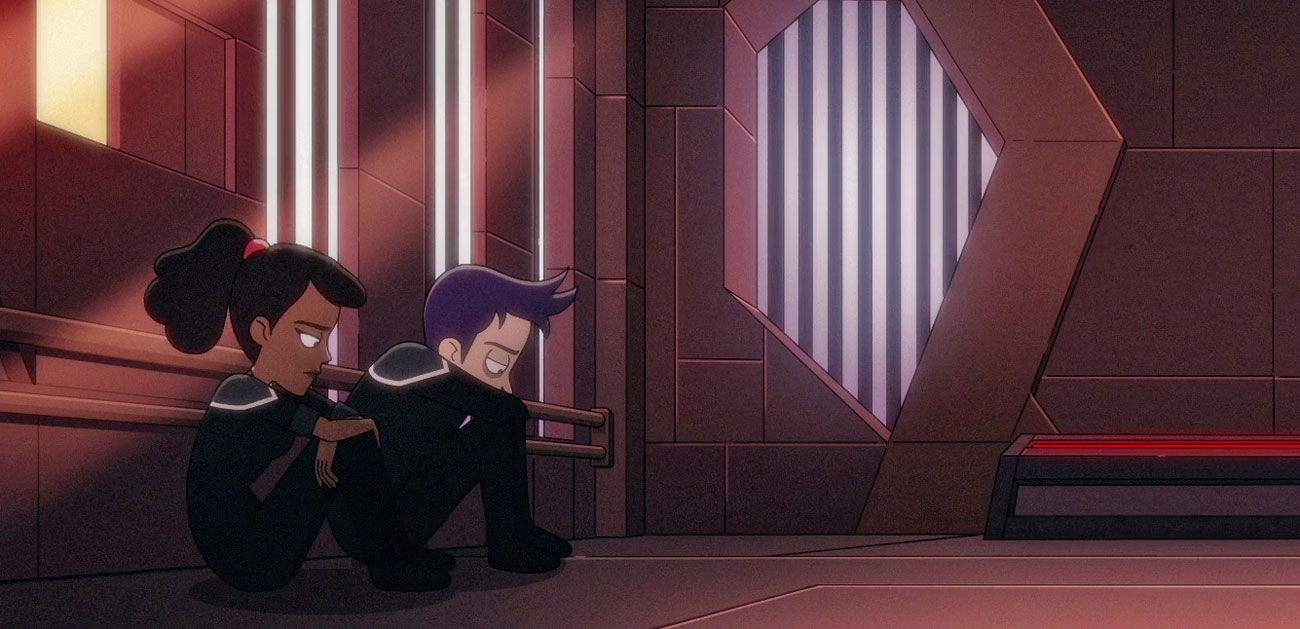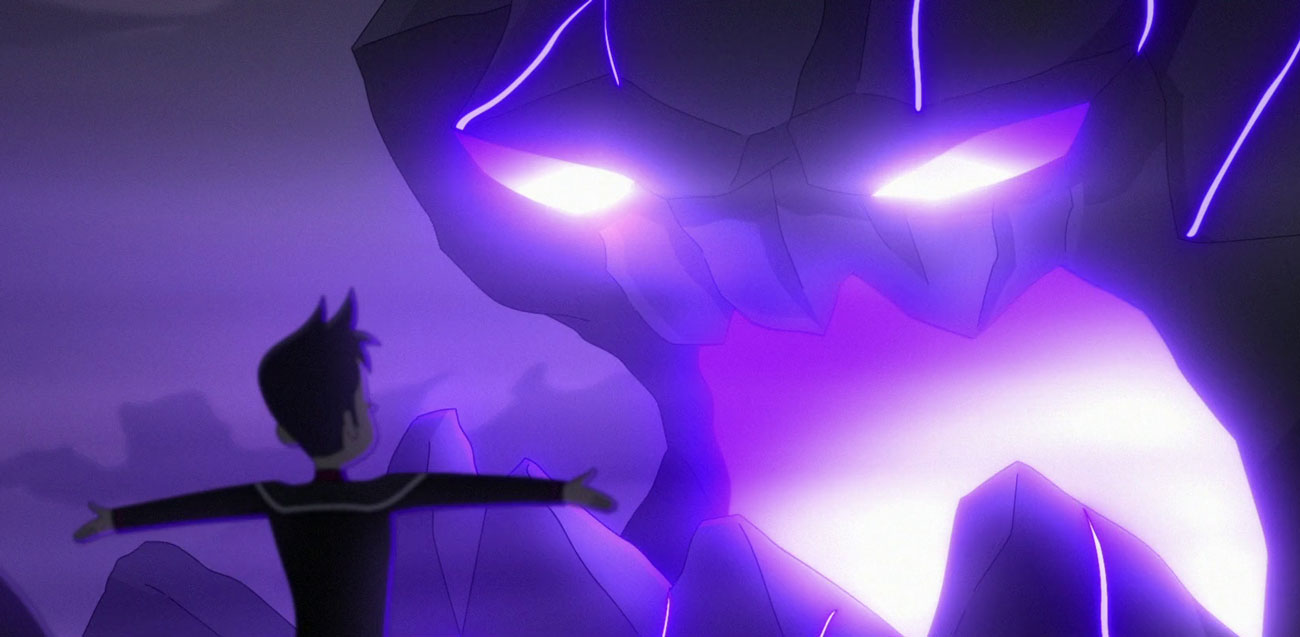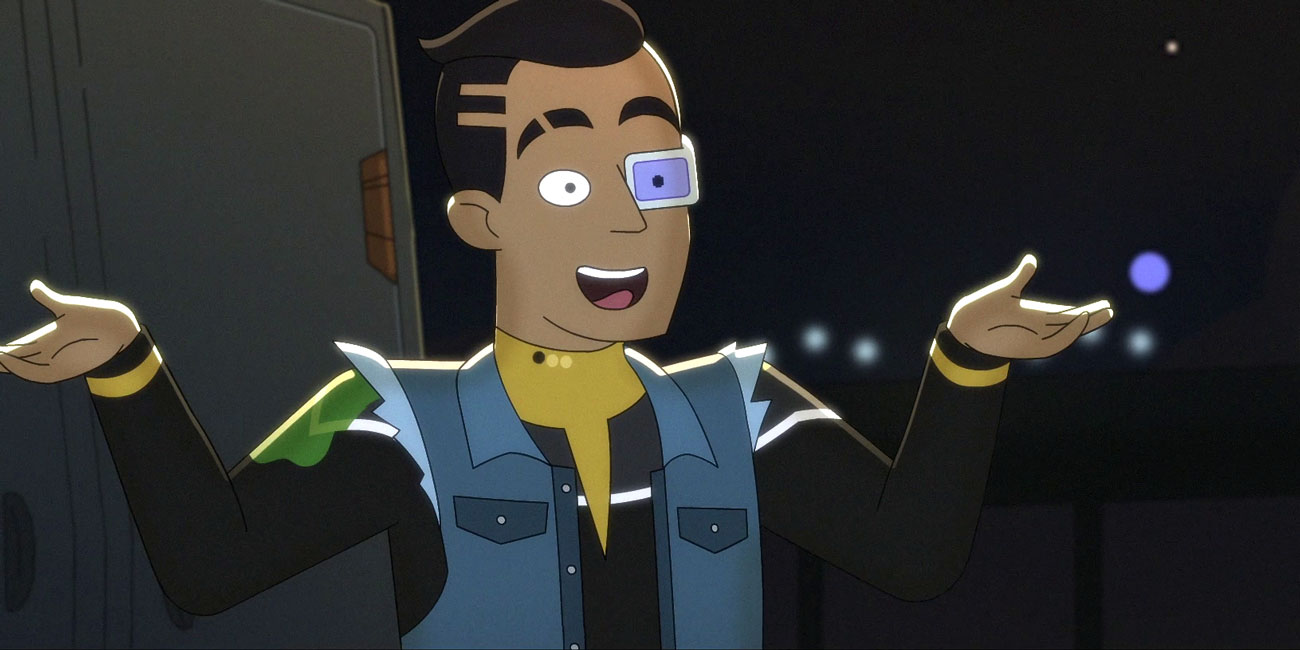Two seasons after what is arguably one of Star Trek: Lower Decks’ best episodes, “Crisis Point,” the Lower Decks team returns to the concept of a loving takedown of the best and worst of Star Trek movies to help our characters grow and advance by repeating the trick in “Crisis Point II: Paradoxus.”
It’s a direct sequel to the original “Crisis Point” in more than just name; where the first season episode chose to use Mariner as its vehicle for Star Trek movie shenanigans, this time the subject of the episode is Boimler.
After Ensign Brad Boimler (Jack Quaid) receives word that his transporter clone William has met a sudden, untimely, and senseless end, Boimler turns to the latest chapter of the Vindicta Cinematic Universe — Crisis Point II: Paradoxus — for meaning. As Tendi and Rutherford play out the holodeck program the way it was designed, Boimler sets off on his own path to find some kind of meaning in the death of his transporter clone.
It’s a lot, and serves up an extremely thoughtful — if not quite as funny — sequel to the original “Crisis Point.”
Where the original “Crisis Point” felt like it leaned a little harder into the Star Trek movie send up than the character development, “Crisis Point II: Paradoxus” shifts the balance in the other direction. This is a character episode through and through, and actually quite a poignant one, particularly for Boimler and Tendi.
“Crisis Point II: Paradoxus” throws us a large number of Star Trek movie tropes — mostly from the bad ones — as a way of sending up the idea that “Crisis Point II: Paradoxus” is a sequel to the original “Crisis Point” and might not be as good. But the most important movie trope it deals with is pulled directly from Star Trek: Generations.
Boimler finds himself dealing with the senseless death of a family member just like Picard in that movie, and seemingly learns an important lesson that will hopefully help the character continue to grow in confidence: you’ll never find joy if you worry about a meaningless death.
Meanwhile, as Ensign Tendi (Noel Wells) is left as “acting captain” in the holoprogram while Boimler sets off on his own quest, she discovers that she has a taste for command. When Rutherford doesn’t take the program seriously, Tendi worries that means that she wouldn’t be respected as a captain, something that she has just realized that she wants for herself.
It’s a fun to see Tendi come to this realization, and set that kind of big career goal for herself. It also says a lot about her relationship with Ensign Rutherford (Eugene Cordero), who is just messing around in the program most of the time, that when he discovers how much it means to Tendi he immediately takes it completely seriously and supports her entirely. It’s another wonderful facet of their relationship, which is one of Star Trek’s best even if it never results in a romantic relationship.
While I don’t know that a third “Crisis Point” would work in the same way as one and two, the second version of this episode is particularly successful at upping the stakes and throwing visuals and ideas at us that would never fit in a regular episode of Lower Decks. Want to see Boimler in the captain’s chair of a Sovereign class ship? You can in “Crisis Point II,” though in this case as “Captain Bosephus Dagger” of the USS Wayfarer.
I like the way that leaning on the holoprogram allows Lower Decks to just let its hair down and have some Star Trek fun. 21st century punks? Sure. Romulan warbirds commanded by evil triplets? Okay! Sign me up!
But the movie tropes wouldn’t work without a strong emotional core to the episode, and seeing both Boimler go through something, and the way that Ensign Mariner (Tawny Newsome) supports him, and then seeing Tendi make a realization about herself, and the way Rutherford supports her — gives the episode a really strong throughline that both lets you enjoy the Star Trek movie tropes, and get a good character episode of Lower Decks in.
And you didn’t think I’d end this part of the review without mentioning that Lower Decks got one of the biggest legacy cameos of all? It really was great to see George Takei lending his voice talents to the show, returning as a version of Hikaru Sulu for the first time since his 1996 appearance on Star Trek: Voyager.
Goodness, this show is a good time for longtime Star Trek fans!
TREK TROPE TRIBUTES
- The fictional villains of “Crisis Point II: Paradoxus” are the Melponar triplets, whose familial relationship (and impressive boob windows on their uniforms) is clearly meant to spoof Lursa and B’Etor, the Duras sisters from Star Trek: The Next Generation and the villains of Star Trek: Generations.
- The story of “Crisis Point II: Paradoxus” is built around a suitable macguffin that doesn’t make a ton of sense — in this case, the Chronogami — which gives us serious “red matter” vibes.
- Mariner comments incredulously on how “Crisis Point II: Paradoxus” can be a sequel to “Crisis Point” given there are hardly any of the same characters — pointing out that the Star Trek movies often have very little in common with each other, despite all being sequels to Star Trek: The Motion Picture!
- Starfleet characters traveling through time and mixing it up with punks is an old classic.
- “Yeah it’s an uneven story that totally ignores the successes of the original. But it’s also a Starfleet movie. Which means it’s worth doing.” That pretty much describes every bad Star Trek outing.
- The rock god on the third moon of Shatnari (har har) comes alive in a similar fashion to the stone temple to “God” in Star Trek V: The Final Frontier. There are then a suitable number of references to how there’s always a twist with god-based episodes.
- The mythical KTYHA that Boimler is seeking is actually Kitty Hawk, in a send up of V’Ger from Star Trek: The Motion Picture.
- I loooooove how William Boimler points out the absurdity of the Section 31 badge. “Isn’t Section 31 supposed to be a big secret? Why would we wear special combadges that advertise who we are?” Such a great joke that makes humor out of something the fans have been wondering about for years.
CANON CONNECTIONS
- The Romulan triplets fly a Valdore-type warbird, introduced in Star Trek: Nemesis.
- “Does it make an alternative cinematic timeline that runs concurrent to our own but with like different people playing younger versions of us?” Mariner asks about the Chronogami, exactly describing the Kelvin Timeline.
- The Federation outpost where the Chronogami was invented is purposefully made to look like Regula I. The top secret video to introduce the project is a send up of the Genesis introductory video from The Wrath of Khan, and Doctor Helena Gibson is a take on Carol Marcus.
- One of the holodeck characters calls out to “let Minooki guide you!” referring back to the D’Arsay god from earlier this season. One of the other characters calls out “the koala smiles on us all!” extending the long-running koala joke from “Moist Vessel.”
- The Starfleet characters at the Aquatic Research Center are all wearing the monster maroon style of Starfleet uniform.
- Neurocine gas, which supposedly killed William Boimler, was previously referenced in “Civil Defense” for its toxic properties.
- The freighter Boimler and Mariner are aboard is the same design as the Batris from “Heart of Glory.”
- The exterior of the Founding of the Federation scene is the matte painting of the Federation Council building from Star Trek IV: The Voyage Home. The interior of the sequence comes directly from “These Are The Voyages.”
- The Romulan’s bomb design is the same as the thalaron bomb from Star Trek: Nemesis.
- Section 31 enters Lower Decks, complete with a Defiant-class ship equipped with a cloaking device!
OTHER OBSERVATIONS
- The Wayfarer uniforms — which may or may not be fictional creations of the mind of Bradward Boimler — are interesting variations on the Star Trek: Nemesis style, with a white stripe separating the grey yoke from the black uniform.
- Boimler sits with the Riker lean when he’s inhabiting the character of Bucephalus Dagger.
- Mariner calls the two Crisis Point tales “the Vindictaverse,” referring to the name of her villainous character from the first episode.
- Boimler is “Bucephalus Dagger,” Rutherford plays “Sylvo Toussant”, Tendi is “Meena Vesper” and Mariner is “Rebecca Doodle” in “Crisis Point II: Paradoxus.”
- The opening credits and the font used for the location names are drawn from Star Trek II: The Wrath of Khan.
- Mariner, who is not terribly impressed with Boimler’s acting, says that “someone took a Winger Bingston class” referring back to the theatrical Starfleet officer seen previously in “Moist Vessel.”
- One of the planets visited in this episode is Tatasciore IX, named after Shaxs voice actor Fred Tatasciore.
- This episode poses some interesting questions about how the holodeck works — and how smart it is — through testing the limits of its adaptive programming.
- I wonder if the Great Soolian Algae Crisis was a real event in Federation history, or just something that Boimler made up for the program? Neither Tendi nor Rutherford say enough about it to make it clear if it’s something they are remembering from history or if it’s just part of the in-holodeck backstory.
- Ransom’s best friends on the Cerritos are Honus the bartender, Nurse Westlake, and Matt the whale from Cetacean Ops.
- We get a snippet of the Chu Chu song, the infamous song from the Zebulon Sisters references in “Terminal Provocations.” Rutherford’s version does not seem to be the one that adds the third Chu.
- Jim Kirk’s Generations cabin has a hot tub. Appropriately.
While the season may have gotten off to a slow start, the run of episodes from “Reflections” through today easily rival the strongest runs of the first two seasons. With the end of last week’s episode teasing a team up of Peanut Hamper and AGIMUS, and this episode putting William Boimler in Section 31, I feel like there are a lot of great parts of Lower Decks’ history and own story that have been set up for some very fun future stories.
![]()
Star Trek: Lower Decks returns with the penultimate episode of Season 3 on Thursday, October 20 on Paramount+ in the United States, Australia, Latin America, and the Nordics, as well as on CTV Sci Fi Channel in Canada and on Prime Video in many other regions.










